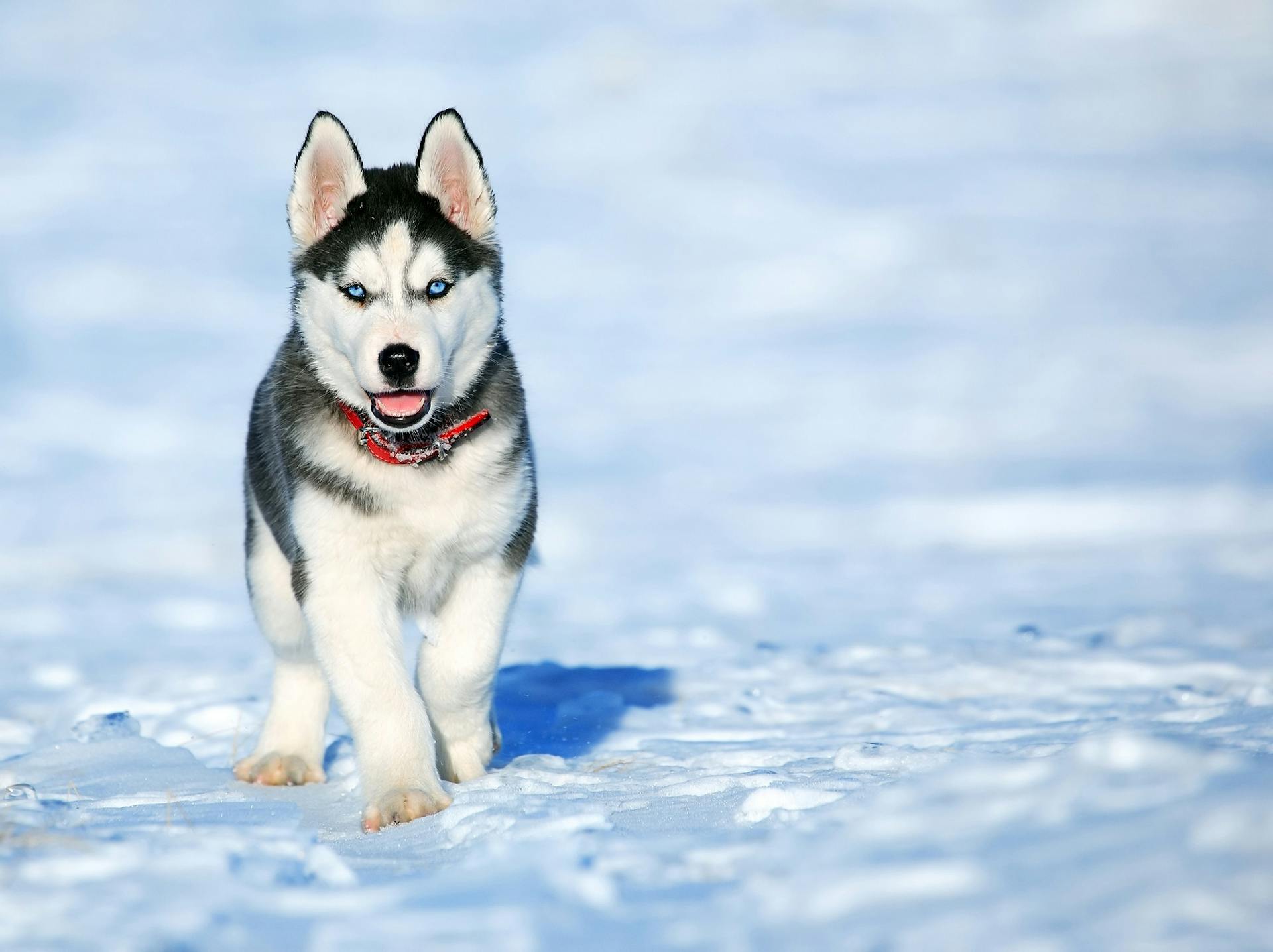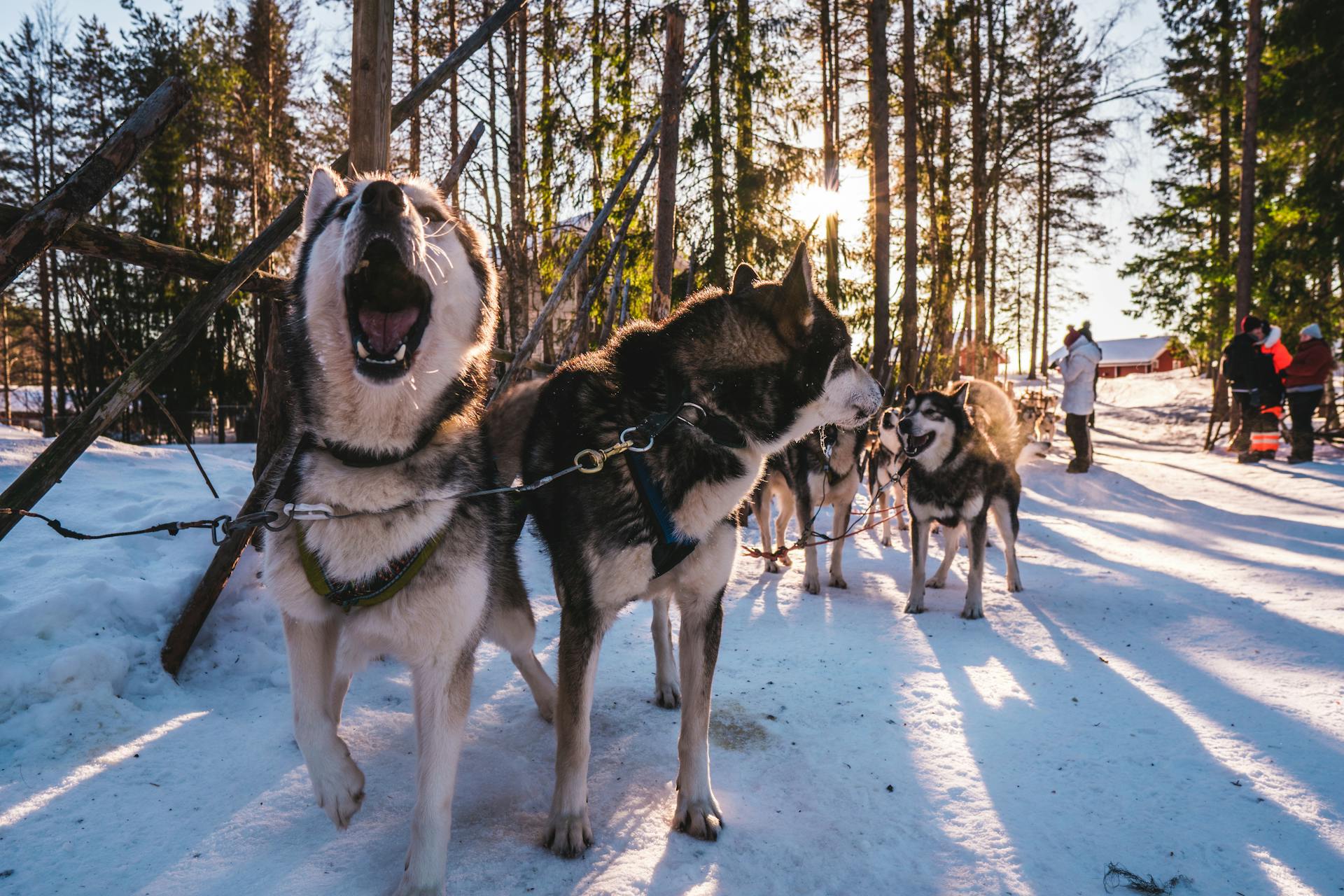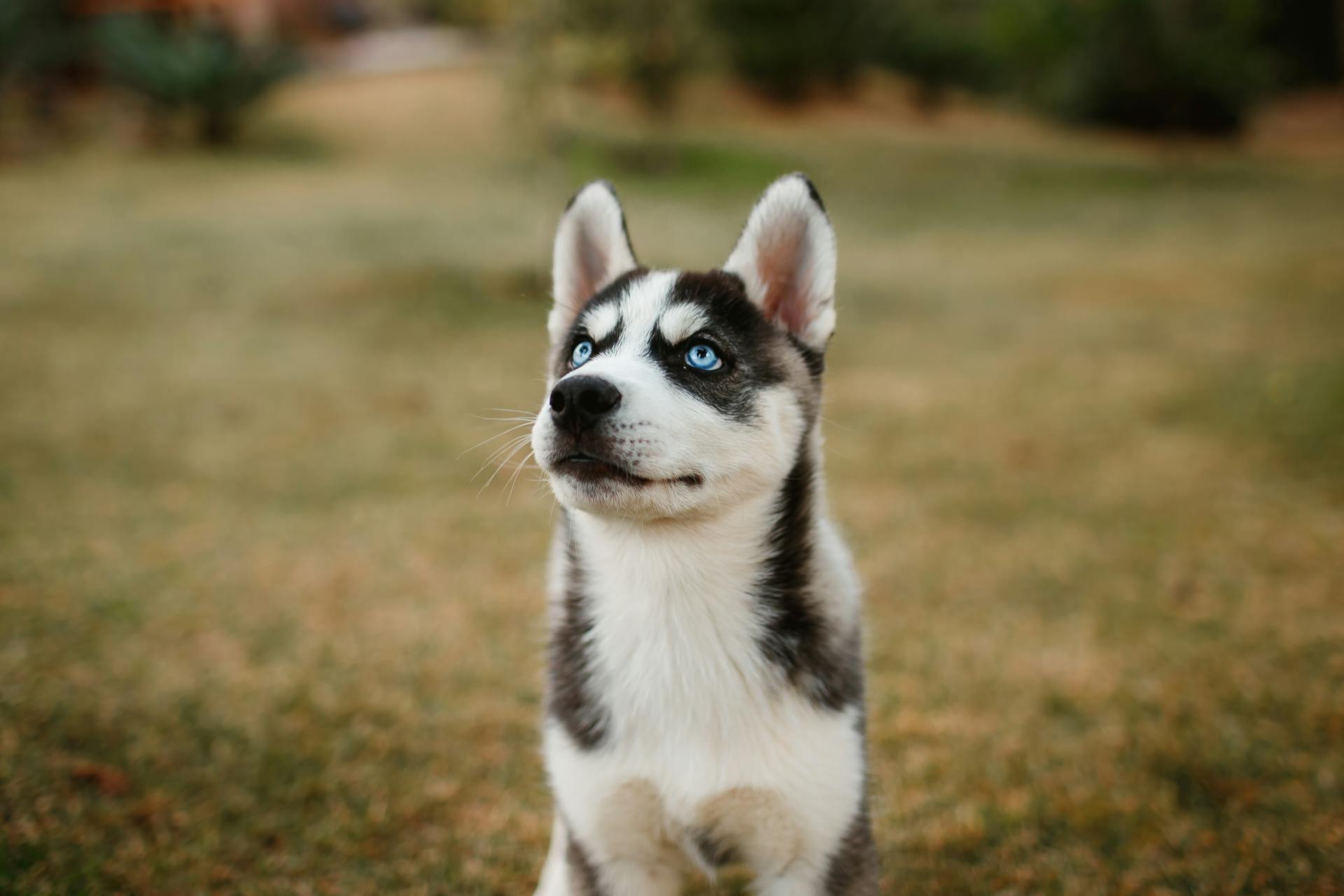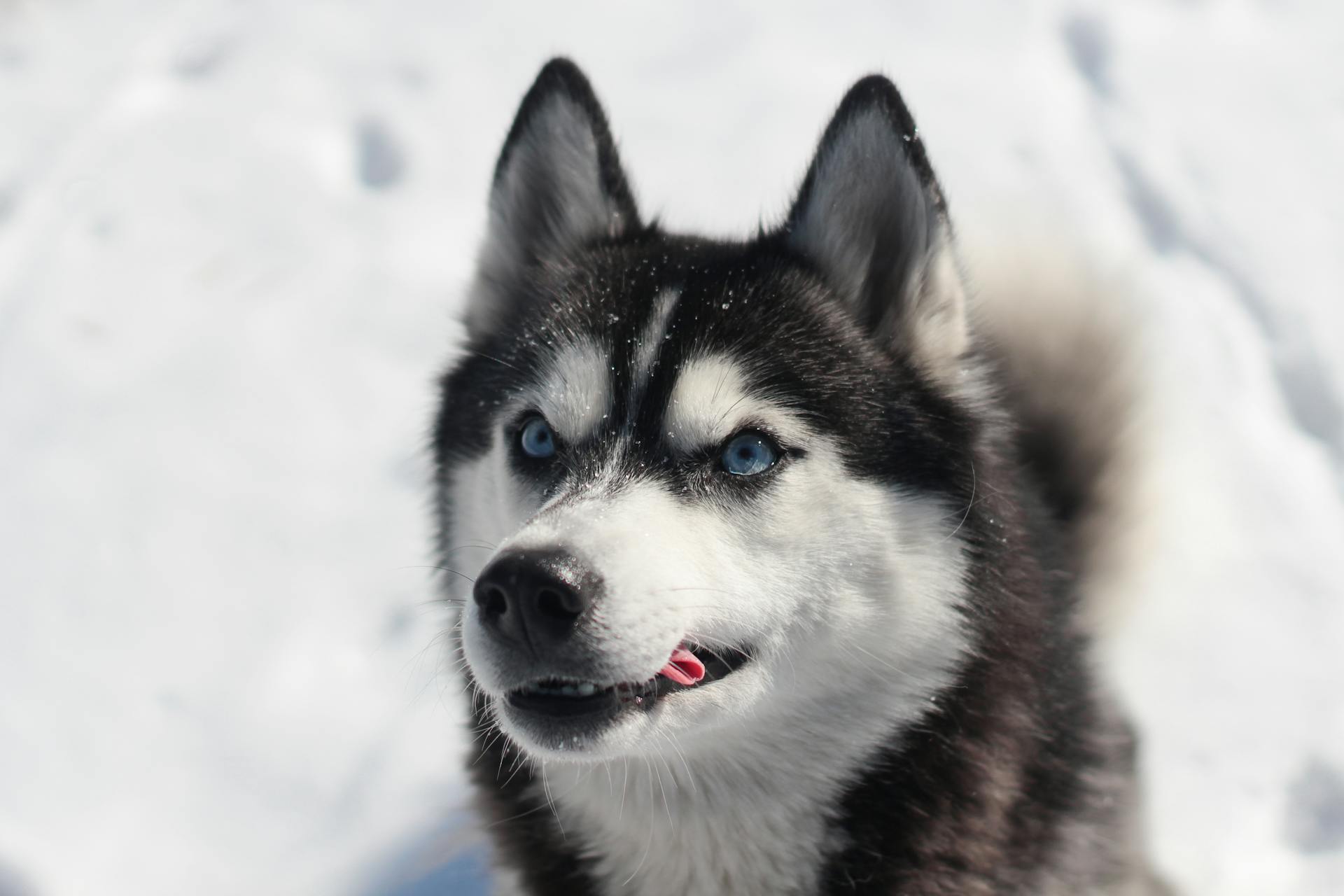
Siberian Huskies are known for their thick double coat, which sheds heavily, especially during spring and fall. They shed to adjust to changing temperatures.
This shedding process is a natural part of their life cycle, and it's essential to understand what to expect if you're considering bringing a Husky into your family.
Siberian Husky Shedding Basics
Siberian Huskies shed twice a year to prepare for seasonal changes, releasing a huge amount of hair going into the summer.
Their iconic double coats consist of a soft, fluffy undercoat and a top layer of fur that's longer, straighter, and harsher, helping to protect them from the elements.
Siberian Huskies continually grow new fur, which means they also continually shed old fur in an ongoing cycle, releasing loose hair every time you pat your dog.
You'll probably notice a summer shed, which is usually the most prolonged and prolific in terms of the amount of hair they lose, and can be variable depending on the weather.
Consider reading: Short Hair Chorkie
Huskies shed a lot, and it's not just a little bit of hair - you'll find yourself pulling hair out in tufts or clumps, and it'll be everywhere, on your clothes, in your food, in your bed.
The good news is that it's only for a few weeks a year, but be prepared for an intense brushing session during shedding season, where the pile of hair you've brushed away can be as big as your husky.
Brushes and Combs
Brushes and Combs are essential tools for managing a Husky's shedding. A good brush or comb can help reduce shedding and keep a Husky's coat healthy.
A slicker brush with fine, bent wire bristles is great for removing loose fur from the undercoat. It's also a good idea to use a wide-toothed comb to detangle and remove mats.
A de-shedding tool, such as the Furminator, can be effective in removing loose fur. Regular brushing with a slicker brush will remove dead and loose fur and stimulate the production of natural oils to keep a Husky's coat glossy.
Expand your knowledge: Are Siberian Huskies Good with Kids
Here are some common types of brushes and combs used for Huskies:
- Slicker brush: good for removing loose fur from the undercoat
- Wide-toothed comb: great for detangling and removing mats
- De-shedding tool (Furminator): effective in removing loose fur
Using the right brush or comb can make a big difference in managing a Husky's shedding.
Shedding Frequency and Patterns
Siberian huskies shed their fur year-round due to their continuous growth of new fur, releasing loose hair every time you pet them.
Huskies blow their coats twice a year, shedding a much greater percentage of hair over a couple of weeks, roughly coinciding with the changing of the seasons.
These twice-annual coat blows can be quite intense, especially during the summer shed, which is usually the most prolonged and prolific in terms of the amount of hair they lose.
The summer shed can be affected by early heat, hot weather, or prolonged hot weather, causing your dog to shed more hair and for a longer period of time.
Huskies shed their coat twice a year, typically in the spring and fall, known as "blowing coat", during which they shed their undercoat in large clumps.
Broaden your view: Bichon Frise Hot Spots
This shedding can last for several weeks and can be quite intense, resulting in a lot of hair around your home.
In addition to seasonal shedding, huskies shed throughout the year, albeit at a lower intensity, as a normal part of their coat maintenance and to help regulate their body temperature.
Huskies usually shed, or "blow their coat", twice a year, in the spring and fall when the days are getting longer or shorter.
This process can result in a lot of hair around your home, and it's possible for huskies to shed at other times of the year based on various triggers other than seasonal change.
Here's an interesting read: Dog Blowing Coat in Winter
Factors Influencing Shedding
Siberian huskies shed year-round due to their ongoing cycle of growing new fur and shedding old fur.
Their thick, double-layered coat is designed to insulate and protect them from extreme temperatures, which means they shed heavily to regulate their body temperature in different environments and climates.
Huskies shed twice a year, coinciding with the changing of the seasons, with the summer shed being the most prolonged and prolific. However, the exact timing can vary depending on factors like early heat waves or prolonged hot weather.
The amount of shedding can vary depending on several factors, including the dog's age, health, and diet. For example, older huskies tend to shed more than younger ones due to a decrease in their skin's elasticity and oil production.
Here are some common factors that can influence shedding in huskies:
- Age: Older huskies tend to shed more than younger ones.
- Health: Dogs with certain health conditions, such as allergies, thyroid problems, or skin infections, may experience excessive shedding.
- Diet: A change in diet can also affect shedding.
- Seasonal changes: Huskies shed twice a year, coinciding with the changing of the seasons.
Other Triggers
Huskies can shed due to stress or anxiety, which can be a result of changes in their environment or routine.
Stress and anxiety can cause a husky to shed more than usual, so it's essential to provide a stable and comfortable living situation.
Hormonal changes can also trigger excessive shedding in huskies.
This can be due to various factors, such as puberty or pregnancy.
Illness can cause a husky to shed more than usual, as their body tries to recover from the infection.
Keep an eye out for any changes in your husky's behavior or appetite that may indicate an underlying health issue.
A change in diet can also affect a husky's shedding, so it's crucial to provide a balanced and nutritious diet.
A lack of exercise can also lead to excessive shedding in huskies.
Regular exercise can help reduce shedding and keep your husky's coat healthy.
Here are some common triggers that can cause excessive shedding in huskies:
- Stress or anxiety
- Hormonal changes
- Illness
- Change in diet
- Lack of exercise
Are Hypoallergenic?
Huskies are not hypoallergenic, and their shedding can cause issues for those with allergies.
Their fur releases allergens into the air, making them one of the worst breeds for people with allergies.
Siberian Huskies are particularly notorious for their heavy shedding.
After having a husky for a couple of years, you'll become attuned to its shedding patterns and habits.
This awareness can make managing their shedding much easier and less overwhelming.
Managing Shedding
Managing Shedding is a crucial part of owning a Siberian Husky. Regular grooming can help manage shedding throughout the year.
To start, Huskies shed their undercoat twice a year, which can be overwhelming. Vacuuming, brushing, and using specialized tools can help reduce shedding. I've found that brushing my Husky daily helps to remove loose fur and prevent matting.
Siberian Huskies need to be brushed and groomed more or less daily to remove loose, shed fur from their coats and stimulate new hair growth. If you don't groom your dog regularly, the shed hair dropped around the house can become prolific.
Bathing your dog is also essential, especially during times when they're blowing their coat. Bathing every six weeks or so is ideal, and it helps to remove shed hair from their coat too. Due to their size and amount of fur, bathing a Husky at home can be quite a challenge.
Readers also liked: Brushing a Bichon Frise
To manage their shedding, it's essential to follow specific grooming techniques, bathing, and skin care. Vacuuming and using specialized tools can help reduce shedding, and shedding blades are another option for removing loose fur from a Husky's coat. These blades have a row of small teeth that can help to remove dead hair from the undercoat.
Here are some key tips to help you manage your Husky's shedding:
- Brush your Husky daily to remove loose fur and prevent matting.
- Bathe your dog every six weeks or so to remove shed hair from their coat.
- Use specialized tools, such as shedding blades, to remove dead hair from the undercoat.
- Vacuum regularly to reduce shedding around the house.
Skin and Health Concerns
As a husky owner, you'll want to keep a close eye on your dog's skin and health. Older huskies tend to shed more due to decreased skin elasticity and oil production.
Regular bathing is essential, but over-bathing can strip their coat of natural oils, leading to dryness and excessive shedding. Bathing huskies once every three months is sufficient.
Huskies are prone to skin conditions like allergies, hot spots, and infections. If your husky is shedding excessively and has red, itchy, or irritated skin, it may be a sign of a skin condition.
Dry skin can lead to excessive shedding, so using a moisturizing conditioner can help keep their skin healthy. Regularly checking their skin for any signs of irritation or infection is also important.
Skin Conditions

Huskies are prone to skin conditions such as allergies, hot spots, and infections. These conditions can cause red, itchy, or irritated skin.
Excessive shedding in a husky may be a sign of a skin condition. If your husky is shedding excessively and has red, itchy, or irritated skin, it's essential to seek professional help from a veterinarian.
A vet can diagnose and treat the underlying issue, which may include medication, topical creams, or changes in diet. Regular visits to the veterinarian are crucial to keep your husky's health in check.
Early intervention can help prevent further health problems and ensure that your husky is healthy and happy.
Recommended read: Shiba Inu Dog Health Problems
Skin Care
Bathing your husky once every three months is sufficient to maintain their cleanliness and skin health.
Over-bathing can strip their coat of natural oils, leading to dryness and excessive shedding.
The Bottom Line
Siberian Huskies shed heavily, particularly during spring and fall, so be prepared for a lot of loose hair.
Daily brushing is crucial during shedding seasons to manage the shedding and keep your home relatively hair-free.
Regular grooming not only reduces loose hair but also promotes healthy skin and coat for your Husky.
Using an undercoat rake or de-shedding brush can effectively remove loose fur and prevent matting.
Shedding is a natural process for Huskies, and with proper care and attention, you can manage to shed and enjoy the company of your beloved Husky for years to come.
Frequently Asked Questions
Why is my Husky not shedding?
Your Husky may not be shedding as much as expected because they might be retaining their existing coat, or they could be one of the few that don't shed a lot during the fall season. This can be due to individual variations in their shedding patterns.
Can you trim husky hair?
Yes, trimming the hair under a Husky's paws is recommended for neatness and traction. However, trimming the coat itself is not recommended, as it can cause harm and compromise the dog's skin protection.
Featured Images: pexels.com


